
Spoiler Warning: There are spoilers ahead for Star Trek: Discovery Seasons 1-4 and Star Trek: Voyager Season 4.
After what seemed like a never-ending six-week break, Discovery has finally returned to our screens! I don’t necessarily mind a mid-season break in principle, but the way Discovery’s was handled was poor from ViacomCBS and Paramount+. Being announced with mere days to spare seems intentional, as if it were deliberately designed to make sure that fans had no opportunity to cancel or suspend their Paramount+ subscriptions. We’ve talked on several occasions recently about the need for ViacomCBS and Paramount+ to get a grip and demonstrate that they’re serious about this whole streaming business – and randomly announced, unscheduled mid-season breaks are not a particularly good look.
The six-week break opened up a gap for Star Trek: Prodigy, though – and if you skipped it or didn’t want to check it out because it’s billed as a show for children, do yourself a favour and reconsider! Prodigy was fantastic, and managed to be a series that really embodied the spirit of Star Trek. Unfortunately it’s only available “officially” if you live in the United States (even Paramount+ in Australia didn’t broadcast the full ten episodes for inexplicable reasons) but I daresay you can find a way to watch if you so choose. Check out my spoiler-free review of Prodigy Season 1, Part 1 by clicking or tapping here.

So let’s talk about All In. The episode had a very strong “Star Wars” feel for the most part, with the gamblers’ den that served as the main setting definitely taking its cues from comparable locales in the Star Wars franchise. The Karma Barge felt like Star Trek’s answer to the Mos Eisley cantina in the original film, complete with shady aliens, drinking, gambling, and criminality – all under the watchful eye of a charismatic crime boss. And I can’t be the only one to notice the similarity between the way the names of Haz Mazaro and Star Wars’ Maz Kanata sound, can I?
I don’t object to these kinds of “out of bounds” places existing in Star Trek, and we’ve seen lawless settlements and shady saloons in basically every iteration of the franchise in some form or another. It’s a trope from westerns that the franchise inherited going all the way back to its inception. In the context of a post-Burn galaxy it makes sense that places like this would exist and would be popular with a certain proportion of the population. I guess the only real thing to say is that this Karma Barge was definitely more Mos Eisley cantina than Quark’s – and that’s a choice that the show’s writers and producers made.

After a break of six weeks, putting Book and Burnham back together makes a certain kind of sense. There are only another five episodes to resolve everything before we get to the end of the season, after all. But if we watch But To Connect and All In back-to-back, and take into account statements made by President Rillak in particular about the in-universe passage of time, the story feels pretty weak. All In kicks off mere hours after the events of But To Connect, and although it arguably says something about the connection or similarities between Book and Burnham that they both chose to visit the same location… it makes the story feel incredibly contrived.
Also, considering the major contrivances required to simply get these two in the same room, I’m not sure this pretty weak story setup actually accomplished very much. Book and Burnham are no closer to resolving their feud than they were at the end of But To Connect, and in some ways are a step further apart having tried and failed to talk it out. I think we needed at least one episode in between But To Connect and the Book-Burnham reunion to really let things sink in for both of them, so going from that conflict over the vote last time (which was itself a rather weak premise that could have been easily resolved) to this episode, with another phase of the conflict in a pretty contrived setup, leaves me struggling to find many positive things to say.

If All In had been a stronger episode overall, with a stronger central premise, perhaps some of those feelings would’ve melted away. If we’d spent longer getting to the Book-Burnham reunion, or if the gambling storylines were better written (to put it bluntly) I could’ve seen myself getting to a place where it would’ve been possible to write off some of these contrivances. But as you can probably tell already, I felt that All In’s story was, once we cut through the contrived fluff, not an especially strong one.
Book and Tarka definitely got the better and more interesting part of the story, as they had to earn the magical macguffin molecule by tracking down a cheater in the gamblers’ den. Though All In skipped over much of Tarka’s process as he tracked down the changeling and modified a piece of equipment to trap them, it was a neat premise and one that, for lack of a better term, had a very “Star Trek” feel to it in what was, as mentioned, a setting that definitely drew on other sci-fi/fantasy influences. As an aside, I don’t think this changeling was a Founder – there are other shape-shifting species in Star Trek, and the way this changeling switched forms didn’t remind me of Odo in any way.
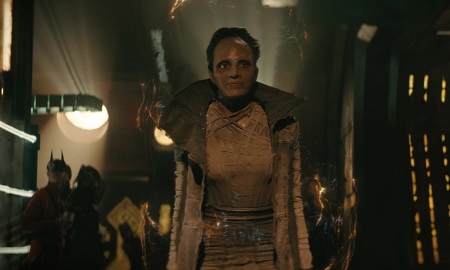
We also got to see glimpses of how well Book and Tarka actually work as a duo. In a scene at the tail end of The Examples we got to see them together for the first time, albeit briefly, and But To Connect showed them coming together to try to win the vote. But it was here, for the first time, that we really got to see their dynamic as a dysfunctional duo – and it works remarkably well. Shawn Doyle and David Ajala play off one another’s strengths beautifully, and they do an excellent job at showing how these two characters have such radically different motivations for undertaking this mission.
There was a moment later in the episode which seemed to hint at Tarka perhaps having some kind of emotional draw to the “friend” he told Book about in But To Connect that arguably goes beyond “just” friendship. It’s possible that this character is a love interest for Tarka, which could be an interesting development if: a) this character is still alive, and/or b) they’re someone we as the audience might be familiar with. Neither of those points is guaranteed, so this could be a red herring that doesn’t go anywhere significant.
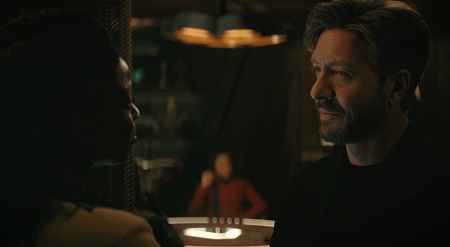
That scene between Tarka and Owosekun was cleverly-written, though, and I honestly can’t tell if Tarka was responding to Owosekun with genuine emotion or was feigning it in some kind of double-bluff. He’s an egotistical man, that’s something we’ve known since even before we first saw him on screen, but whether he’s capable of lying and manipulating at that level to throw people off-balance is unclear right now.
All In was a good episode for Owosekun, giving her a storyline comparable in scale, at least, to Detmer’s in Season 3. A lot of folks have complained about Discovery not making good use of its secondary cast – the bridge crew in particular – so this might be the writers and producers responding to those criticisms. A similar role could have been created for Burnham or several other main cast members – so the choice to put Owosekun in this situation was definitely a deliberate one.

It was definitely a sweet moment to have Burnham and Owosekun paired up, and they worked well as a character duo for this part of the story. The moment between them on the shuttle was perhaps the strongest, at least from an emotional point of view, and aside from episodes like Explorers, where Captain Sisko and Jake went on their own adventure, it’s got to be one of the very few missions in Star Trek’s 800+ episodes where both principal characters were black. Add into the mix Book and the only non-black participant in this story was Tarka.
Unfortunately, though, I felt that Owosekun’s big fight was not well-constructed. This was the central turning point of the mission for her and Burnham, and there are basically two ways to interpret what happened. Either Owosekun was, as her rivals later alleged, essentially hustling the fight by throwing the first two rounds – which I don’t believe, based on the extent of her injuries and her interactions with Burnham – or the fight was simply badly-written and poorly-filmed, not allowing us as the audience to see any of the process involved as Owosekun presumably tried to figure out how to outplay her opponent.
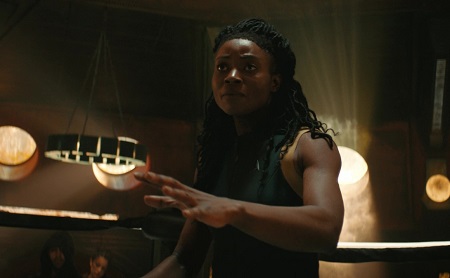
From where I was sitting, here’s how it looked like the fight went down: Round 1, Owosekun got her butt kicked incredibly easily by a far larger, stronger opponent. Round 2: the exact same thing happened. Round 3: out of nowhere, and with all of their money on the line, Owosekun suddenly became 10x stronger and was able to win by magic.
We needed to see something – anything, really – to indicate what was going on. Was Owosekun using the first two rounds to spot weaknesses or patterns in her opponent’s fighting style that she later exploited? If so, that was subtle to the point of being hidden. Was she, in fact, hustling, knowing that the odds would get better with each defeat? Again, if so, that was not communicated to us as the audience. Fights don’t work like this in any contact sport in the real world – so either the explanation is childish writing, saying that Owosekun “got good” at the perfect moment, or the explanation is bad writing and/or filming and editing, meaning that essential elements of the story were simply not well-communicated to us as the audience.

In a story that was already choked by the contrivance of Book and Burnham finding their way to the same place within hours of the events of the previous episode, the poor way in which the fight was executed on screen added to the sense that All In was just not working very well. It was exciting in the moment, I will happily concede that point. And Oyin Oladejo did a creditable job at making me feel that Owosekun was in danger, but determined. Combined with her scene with Tarka later on, it was her best episode of the season so far, and her best performance since That Hope Is You, Part 2 in Season 3. It’s just a shame that the material itself wasn’t particularly strong.
The final part of the episode depicted a card game with Burnham, Book, and two nobodies, with the magical macguffin molecule on the line. And here’s a piece of free advice to the writers of Star Trek, Star Wars, or literally any other sci-fi or fantasy franchise: if you’re going to make a card game an essential part of your story, either make it a familiar card game or explain the rules. Spending nearly ten minutes watching people play a card game that was impossible to follow because it used different designs for the cards and different rules was not entertaining in any way, and this sequence was the episode’s weakest by far.
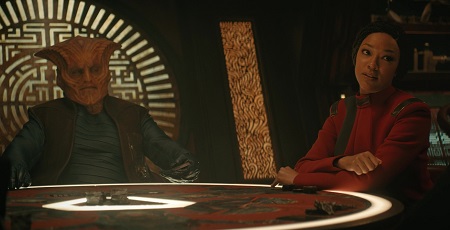
The game was called Leonian poker, and despite the “poker” moniker, the rules were not explained at all. The non-face cards had a vaguely familiar design, but were different enough that it wasn’t easy to see at a glance who was winning or who had a strong hand. And this sequence dragged as a result. Now I will freely admit that watching professional poker is not something I care about in the slightest, but at least if I do watch a poker game I know the rules and can follow what’s going on. Here, a combination of the card designs, lack of clarity over the rules, and the pacing of the sequence itself meant that it was impossible to follow what was happening. This led to a deeply unsatisfying feeling of being on the edge of my seat hoping Book and Burnham could defeat the “Emerald Chain holdouts,” but not knowing what was going on or who was in a good position. The entire sequence was just frustrating.
When designing any kind of fictional card game, it needs to either have its mechanics explained, or be visually very easy to follow – or ideally both. This game, while it may or may not have followed the basic rules of poker, was neither explained nor visually simple enough to be intuitively understood, and I think it’s that combination that detracted from this sequence. If it had been a shorter sequence it might’ve worked better, but it lasted almost eight minutes – and those minutes really did seem to drag.
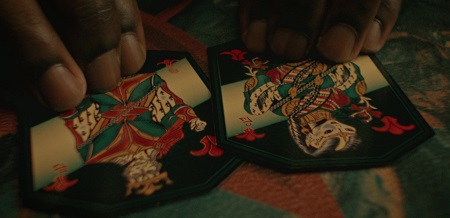
The upshot of all of this was that Book won the game, meaning that he and Tarka could escape with the magical macguffin molecule. I think there was something at least somewhat visually underwhelming about this isolynium, too, that made the stakes of the whole gambling operation – and the threat from Burnham that Book was crossing a line that he “could never come back from” – feel a bit anticlimactic.
In the real world, of course, we have materials like plutonium and uranium which don’t look like much, but are very dangerous, and isolynium is clearly modelled after elements like those. But it doesn’t make for a visually impressive presentation in the way that, say, a barrel of glowing, pulsing, neon pink goo might have had. That’s a deliberate aesthetic choice on the part of the show’s creators – but coming in an episode that had a number of other weak elements, the fact that the highly sought-after prize that all of our characters were desperate to procure was a vial of nondescript metallic flakes no bigger than a coffee mug was definitely an anticlimax. I didn’t know what to expect from isolynium – as far as I know the material is new to Star Trek – but the way the magical macguffin molecule was presented felt like a bit of a let-down in visual terms. Discovery has done some exceptionally interesting things with some of its visual effects across all four seasons, including in a number of unimportant or background areas. For something so vital to the plot to be so visually uninspired made this moment underwhelming.
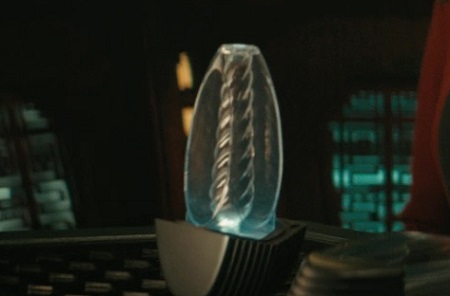
All of this led us to Book and Tarka taking the magical macguffin molecule and leaving, planning to build the weapon. I don’t really see what was stopping Burnham having the USS Discovery on standby to jump in and try to apprehend them after they’d left the barge (which was, understandably, neutral ground). But I suppose that’s a bit of a nitpick. Technologies like the Spore Drive can feel kind of overpowered, so using them sparingly is probably no bad thing! What’s the betting, though, that Tarka already figured out about the tracking device and leads Burnham and the rest of Starfleet to a dead-end? Maybe I’ll save that one for my theory update!
The conflict between Rillak, Vance, and Burnham was one that had the potential to be interesting, but it strayed very close to feeling as though Rillak in particular, but also Vance, were lashing out at Burnham for something that she couldn’t have reasonably been expected to predict. Book’s turn in But To Connect was sudden, and their theft and escape came 90% from Tarka – he was the one who stole the Spore Drive prototype. I can understand the frustration that Rillak in particular would have as she tries to keep the Federation united, and I think Chelah Horsdal did a good job portraying that complex emotional state.
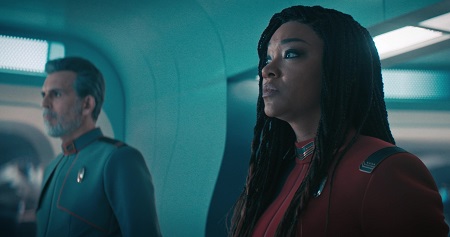
It was also somewhat of a rarity to see Admiral Vance get a bit of a dressing-down from the Federation President. We’ve usually seen Vance very composed and in control, but this situation has exposed a vulnerability for him, as he fears not being able to see his family – or even for their safety – in the event of war with Unknown Species 10-C. Again, a stellar performance from Oded Fehr communicated Vance’s emotions expertly. I also liked that Vance was willing to find loopholes and bend the rules for Burnham, something that I think he would never have considered under normal circumstances.
As the episode was drawing to a close we got a tiny tidbit of information about Unknown Species 10-C. Much of the rest of the episode felt like a detour, so it was important in the closing moments to advance the season’s main story in some way. The revelations this week were that Unknown Species 10-C appear to have some method of cloaking an entire star system – making them far more powerful than the Federation had been anticipating – and that the DMA is designed to harvest a particular particle: boronite. This could be a reference to the Voyager episode The Omega Directive, in which boronite was said to have been used by the Borg to synthesise an omega molecule – one of the most powerful substances in the Star Trek galaxy.
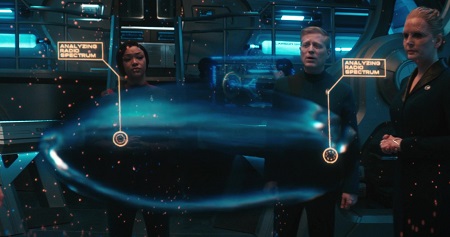
This sequence was cut a little short for me; I felt Discovery could have made more of the explanation of this new angle. The DMA being akin to a mining tool confirms what I’d been suspecting – that it isn’t a weapon – but the scene in which this was explained was very short on detail. Burnham makes huge assumptions based on only a few pieces of information, and may not have the complete picture. For storytelling reasons I daresay her assumptions are accurate and I’m not expecting any of it to be reversed or undone, but I feel like a longer sequence with a bit more time for debate and discussion could have got us to the same place in a bit more of a believable way.
Finally, one of the more understated moments in All In was actually one of the best. Dr Culber had been feeling overwhelmed with his role as ship’s counsellor, and that slow build finally boiled over in what was a rare emotional moment in an episode that had its focus elsewhere. The sequence between Dr Culber and Stamets in their quarters was tender and sweet, and reinforces how the pair really are Discovery’s emotional core.

It also tapped into a theme that Discovery has been running all season – and going back to last season, too: trauma. Different members of the crew have come to stand for different responses to trauma and different parts of the grieving process. We saw Tilly choose to take a very different path, leaving the ship. Gray returned to Trill to try to pick up the pieces of his training. Book had been most strongly affected by grief and ended up going down a dark path. And in Dr Culber’s case, he’d been throwing himself into his work at the expense of taking care of himself.
Feeling that he had failed Book, and also failed to prevent Book from taking the actions he took in But To Connect, Dr Culber was blaming himself and taking it as a personal failure. Stamets seemed to be able to get through to him, though, and that’s definitely a positive thing. Showing how love can cut through moments like this is something that we’ve seen Discovery do on occasion, and it was powerful here.

So I think that’s it for All In. Overall, I’d say it was a bit of a disappointment, despite some individually strong performances and well-constructed moments. The central conceit of putting Book and Burnham back together in such a random way didn’t work for me, and as a result much of the drama at the gamblers’ den felt contrived. The climactic card game was too difficult to follow, leading to a sequence that dragged on far too long and was frustrating to watch, and when All In did find time for fun or interesting moments, they tended to be cut short in favour of returning to the contrived, less-interesting side of the story.
I don’t want to say this is “the worst episode of the season,” because that makes it sound like I hated it and it was irredeemably terrible. I don’t think All In was an awful episode; it’s certainly streets ahead of the likes of Season 2’s The Red Angel. But it was a bit of a let-down, and a weak reintroduction to Discovery after its six-week break.
With only five episodes remaining, there’s still a lot of work to do; All In didn’t move the needle in a major way. Tarka and Book are still on the run, planning to build their weapon. Unknown Species 10-C is still out there and still hidden. The DMA is still doing its thing, flitting about the galaxy. And Starfleet is still two steps behind both. It will take a lot to bring Season 4’s storylines together and start wrapping things up! I hope Discovery is up to the task.
Star Trek: Discovery Season 4 is available to stream now on Paramount+ in the United States, Scandinavia, Latin America, and Australia. The show is on Pluto TV in the UK, France, Germany, Italy, and other parts of Western Europe at 9pm on Fridays and Saturdays. Individual episodes or the full season can be purchased on iTunes, Amazon Video, and possibly other platforms in the UK, parts of Europe, and select other countries. The Star Trek franchise – including Discovery and all other properties mentioned above – is the copyright of ViacomCBS. This article contains the thoughts and opinions of one person only and is not intended to cause any offence.

